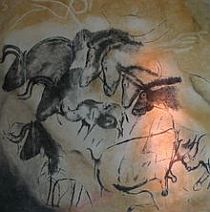


Werner Herzog: Cave of Forgotten Dreams

What does a cave being enclosed for thousands of years sound like? Or smell like? This film actually tries to tell us, but first of all it shows us what it looks like. Or to be more precise, it shows us what the 30.000 years old cave paintings look like. And let me tell you right away, that despite being a 3D sceptic I was really flabbergasted by the effect that this format gives you; a unique sense on how the ancient artists used the curves and hollows of the cave walls to create effects that are right down spectacular. Even from today’s perspective this is world class art!
The paintings do take up a lot of time in this film and you actually get the strange sensation that even Herzog himself was overwhelmed by the art in these caves and thus has made a slightly more conventional documentary. We do get a lot of his trademarks, though: The philosophical narration, the “leading” questions to interviewees and the oddball characters, for instance the “perfumerist” who is skilled in finding hidden caves using his nostrils. Also, a typical Herzog-moment comes when his voice narrates that the footprints of a wolf and an 8-year-old boy were found next to each other. Did the wolf stalk the boy, did they walk together as companions or were the footprints sat 10.000 years apart? “We will never know”. Herzog also wants to put art, music and the understanding of human evolvement into perspective and it really does work. But first and last are the paintings themselves of paramount interest to him. Even when we almost think the film is over, we get the best seven or eight minutes of them all: the camera dwelling on the walls with very simple lighting effects and some really beautiful music – an original score by Ernst Reijseger as far as I can detect.
However, a few “buts” arose in my mind. At an early point in the film, one of the scientists asks the crew to be silent so we can hear the sounds of the cave. Herzog can’t stand that silence more than 10 seconds but soon adds a heartbeat and then music, and shortly it gives you an uneasy feeling about the director’s choices. And apart from when we see the paintings themselves; the 3D format is interesting at best and somewhat annoying and distracting at worst.
But in the end the film is just wonderful and Herzog does the unthinkable: he lets us feel that he put the matter of the film in a predominant position because he didn’t have a choice. These paintings are essential to mankind, the film says, and I agree.